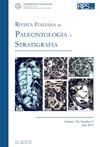扩大了假花甲虫幼虫的记录,其末端突出
IF 1.9
3区 地球科学
Q2 GEOLOGY
引用次数: 11
摘要
甲虫幼虫对总生物量的贡献很大,但它们经常被忽视和开发不足。蜱虫科的幼虫,也被称为假花甲虫,过着隐藏在木头里的生活,观察者很难接近。在那里,它们有助于木材分解和碳循环。尽管它们的生态作用非常重要,但这些幼虫的研究相对较少。这对于这个群体现存的以及化石代表来说都是正确的。这种知识差距似乎不是基于材料的有限可用性,而是由于材料研究不足造成的。在这里,我们报告了新的标本,其中7个是现存的,12个是化石。化石标本来自4000万年前的波罗的海琥珀(始新世)或1亿年前的缅甸琥珀(白垩纪),后者代表了这些幼虫的最古老记录。这里考虑的所有试样都有一个大的、细长的末端。我们对迄今为止保存完好的所有已知幼虫标本(共33个标本:17个现存,14个始新世,2个白垩纪)的末端形状进行了概要分析。始新世和现存标本之间存在可识别的差异,但尚不清楚这是由于不同的幼虫阶段还是进化的影响。本文章由计算机程序翻译,如有差异,请以英文原文为准。
EXPANDING THE RECORD OF LARVAE OF FALSE FLOWER BEETLES WITH PROMINENT TERMINAL ENDS
Beetle larvae contribute to the overall biomass with a great share, yet they often stay unnoticed and underexplored. Larvae of the group Scraptiidae, also called false flower beetles, lead a life hidden in the wood, not easily accessible for observers. There, they contribute to wood decomposition and carbon cycling. Even though their ecological role is of great importance, these larvae have been comparably rarely studied. This is true for extant as well as fossil representatives of this group. It seems that this knowledge gap is not based on the limited availability of material but results from insufficiently studied material. Here we report new specimens, of which seven are extant and twelve are fossil. Fossil specimens are either from 40-million-year-old Baltic amber (Eocene) or 100-million-year-old Myanmar amber (Cretaceous), the latter representing the oldest record of these larvae. All specimens considered here possess a large, elongated terminal end. We performed an outline analysis of the shape of this terminal end for all so far known larval specimens sufficiently well preserved (in total 33 specimens: 17 extant, 14 Eocene, 2 Cretaceous). There is a recognisable difference between Eocene and extant specimens, yet it remains unclear whether this is due to different represented larval stages or an effect of evolution.
求助全文
通过发布文献求助,成功后即可免费获取论文全文。
去求助
来源期刊
CiteScore
3.60
自引率
4.30%
发文量
28
审稿时长
>12 weeks
期刊介绍:
The Rivista Italiana di Paleontologia e Stratigrafia was founded in 1895. It publishes original papers dealing with all fields of paleontology and of stratigraphy, from Italy and the Mediterranean to the Tethys, as well across the globe from China to North America.

 求助内容:
求助内容: 应助结果提醒方式:
应助结果提醒方式:


